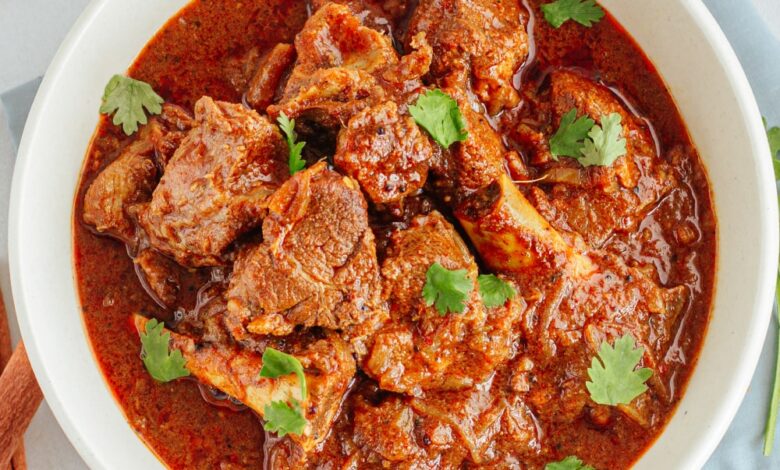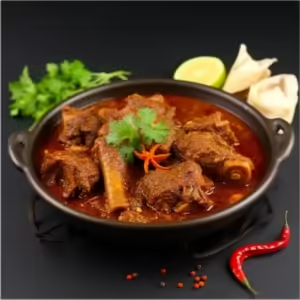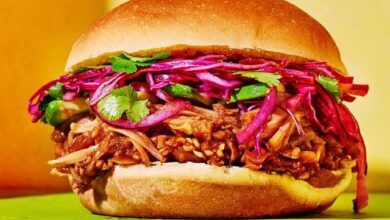Mutton Masala Recipe
Mutton Masala Recipe

Mutton Masala Recipe Introduction:
Mutton Masala combines succulent pieces of mutton with a blend of aromatic spices, tomatoes, and sometimes onions and garlic, resulting in a hearty and comforting meal. The key to a great Mutton Masala lies in its spice mix and the slow cooking process that ensures the meat becomes tender and flavorful. Whether you prefer it mild or spicy, this dish can be adjusted to suit your taste.

Mutton Masala Recipe Ingredients:
For Marination:
- 500 grams mutton (or lamb), cut into chunks
- 1/2 cup plain yogurt
- 1 tablespoon ginger-garlic paste
- 1 teaspoon turmeric powder
- 1 teaspoon red chili powder
- Salt to taste
For the Curry:
- 2 tablespoons cooking oil or ghee
- 2 large onions, finely chopped
- 2-3 tomatoes, finely chopped or 1 cup tomato puree
- 1 tablespoon ginger-garlic paste
- 1 teaspoon cumin seeds
- 1-2 green chilies, slit (optional, for extra heat)
- 1 teaspoon coriander powder
- 1/2 teaspoon turmeric powder
- 1-2 teaspoons red chili powder (adjust to taste)
- 1 teaspoon garam masala
- 1/2 teaspoon cumin powder
- 1/2 teaspoon fennel seeds (optional, for added aroma)
- 2-3 whole cloves
- 1-2 green cardamom pods
- 1 small cinnamon stick
- 1 tablespoon tomato ketchup (optional, for added sweetness)
- 1/2 cup water (adjust for desired consistency)
- Salt to taste
For Garnishing:
- Fresh cilantro (coriander leaves), chopped
- Lemon wedges (optional)
Optional:
- 1/4 cup heavy cream or coconut milk (for a richer, creamier texture)
- 1 tablespoon roasted and ground nuts (like almonds or cashews) for added richness
Mutton Masala Recipe Ingredient Tips:
1. Mutton/Lamb:
- Quality: Use fresh, well-marbled mutton or lamb for the best flavor and tenderness. Ask your butcher for bone-in pieces, as bones add depth to the curry.
- Cut Size: Cut the mutton into uniform chunks to ensure even cooking. If using tougher cuts, consider marinating for a longer time.
2. Yogurt:
- Consistency: Use plain, full-fat yogurt. It should be smooth and not overly tangy. Yogurt helps tenderize the meat and adds a creamy texture to the sauce.
- Marination: Ensure the yogurt is well-mixed with the spices in the marinade for even flavor.
3. Onions:
- Caramelization: Sauté the onions until they are golden brown, not just translucent. This caramelization adds a rich, sweet flavor to the curry base.
- Consistency: Chop the onions finely for a smooth curry base. You can also blend the onions if you prefer a smoother texture.
4. Tomatoes:
- Type: Use ripe, juicy tomatoes for a tangy and rich sauce. Canned tomato puree can also be used for convenience and consistency.
- Preparation: Cooking the tomatoes until the oil separates helps in developing a deeper flavor. If using tomato puree, adjust the quantity based on its acidity and thickness.
5. Spices:
- Freshness: Use fresh whole spices and ground spices for the best flavor. Whole spices should be toasted slightly to release their oils and enhance their flavor.
- Adjust to Taste: Adjust the amount of chili powder and garam masala to suit your spice preference. If you prefer a milder curry, use less chili powder and garam masala.
6. Ginger-Garlic Paste:
- Homemade: For the best flavor, use freshly made ginger-garlic paste. Blend equal parts fresh ginger and garlic for a strong, aromatic paste.
- Quantity: Adjust the amount based on your taste preference, as too much can overpower the dish.
7. Cooking Oil/Ghee:
- Choice: Ghee adds a rich, nutty flavor, but cooking oil (like vegetable oil or canola oil) works well too. If using ghee, you might need less of it due to its rich flavor.
- Temperature: Ensure the oil or ghee is hot before adding spices to prevent them from burning.
8. Water:
- Consistency: Adjust the amount of water based on the desired consistency of the curry. Add more water for a thinner sauce or reduce it for a thicker one.
- Cooking Method: If using a pressure cooker, add less water initially and adjust as needed based on the consistency after cooking.
9. Cream/Coconut Milk:
- Optional: Adding cream or coconut milk can make the curry richer and creamier. Coconut milk works well for a more tropical flavor, while cream adds a smooth richness.
- Add at the End: Stir in cream or coconut milk towards the end of cooking to avoid curdling and to maintain a creamy texture.
10. Fresh Cilantro:
- Garnish: Fresh cilantro adds a burst of freshness and color. Add it just before serving to retain its vibrant flavor and appearance.
- Chop Finely: Chop cilantro finely for even distribution and a better texture.
Mutton Masala Recipe Equipment Needed:
- Large Mixing Bowl:
- For marinating the mutton with yogurt and spices.
- Heavy-Bottomed Pan or Dutch Oven:
- Ideal for cooking the mutton and developing flavors. A heavy-bottomed pan or Dutch oven ensures even heat distribution and prevents burning.
- Pressure Cooker (Optional):
- Useful for speeding up the cooking process if you want to tenderize the mutton more quickly. It’s not essential but can be a time-saver.
- Cutting Board:
- For chopping onions, tomatoes, and other vegetables. Ensure you have a clean, sturdy board to work on.
- Sharp Knives:
- For cutting mutton into chunks, chopping onions, and preparing other ingredients. A good quality, sharp knife makes preparation easier and more efficient.
- Grater or Food Processor (Optional):
- For grating ginger and garlic if you prefer to make fresh ginger-garlic paste rather than using pre-made paste.
- Garlic Press (Optional):
- To crush garlic if not using pre-made ginger-garlic paste.
- Measuring Spoons and Cups:
- To measure spices and liquids accurately.
- Wooden Spoon or Spatula:
- For stirring and mixing the curry to ensure even cooking and to prevent sticking.
- Ladle or Serving Spoon:
- For serving the curry once it’s cooked.
- Strainer or Sieve:
- If using whole spices, you might want to strain them out before serving for a smoother curry.
- Small Bowls or Containers:
- For holding pre-measured spices and ingredients as you cook.
- Tongs or Serving Utensils:
- For handling the cooked mutton and transferring it to serving dishes.
- Blender or Food Processor (Optional):
- For blending onions and tomatoes into a smooth paste if desired. This helps create a smoother curry base.
- Pot or Pan Lid:
- To cover the curry while simmering to retain moisture and flavor.
- Timers (Optional):
- Useful for keeping track of cooking times, especially if you’re using a pressure cooker.
Having the right equipment can streamline the cooking process and help you achieve a delicious Mutton Masala. Enjoy your cooking!
Mutton Masala Recipe Step-by-Step Instructions:
- Marinate the Mutton:
- Combine Ingredients: In a large mixing bowl, combine the mutton chunks with yogurt, ginger-garlic paste, turmeric powder, red chili powder, and salt.
- Mix Well: Ensure the mutton is thoroughly coated with the marinade. Cover and refrigerate for at least 1 hour, or overnight for best results.
- Prepare the Curry Base:
- Heat Oil/Ghee: Heat 2 tablespoons of cooking oil or ghee in a large pan or Dutch oven over medium heat.
- Add Whole Spices: Add 1 teaspoon cumin seeds, 2-3 whole cloves, 1-2 green cardamom pods, and 1 small cinnamon stick. Sauté for about 1 minute until fragrant.
- Sauté Onions: Add the finely chopped onions. Cook, stirring frequently, until they turn golden brown. This should take about 8-10 minutes.
- Cook the Aromatics:
- Add Ginger-Garlic Paste: Stir in 1 tablespoon of ginger-garlic paste and cook for another minute until the raw smell disappears.
- Add Tomatoes: Add the finely chopped tomatoes or tomato puree. Cook until the mixture thickens and the oil starts to separate from it, about 5-7 minutes.
- Cook the Mutton:
- Add Marinated Mutton: Add the marinated mutton to the pan. Sauté for 5-7 minutes until the mutton pieces are browned.
- Add Spices: Mix in 1 teaspoon coriander powder, 1/2 teaspoon turmeric powder, 1-2 teaspoons red chili powder, and 1/2 teaspoon cumin powder. Stir to coat the mutton evenly with the spices.
- Add Water: Pour in 1/2 cup water and stir well. Bring the mixture to a boil.
- Simmer:
- Cover and Cook: Reduce the heat to low, cover the pan, and let it simmer. If using a pressure cooker, cover and cook for 20-30 minutes (about 3-4 whistles) until the mutton is tender. For a regular pan, simmer for 45 minutes to 1 hour, until the mutton is cooked through and tender. Stir occasionally and add more water if needed.
- Finish the Dish:
- Adjust Seasoning: Taste and adjust seasoning with salt and spices if necessary.
- Add Garam Masala: Stir in 1 teaspoon garam masala for a burst of flavor.
- Optional Cream/Coconut Milk: If using, add 1/4 cup of heavy cream or coconut milk and cook for an additional 5 minutes for a richer texture.
- Garnish and Serve:
- Garnish: Sprinkle freshly chopped cilantro on top.
- Serve: Serve the Mutton Masala hot with basmati rice, naan, roti, or paratha. Lemon wedges on the side can add a refreshing touch if desired.
Enjoy your flavorful and aromatic Mutton Masala, perfect for a hearty meal!
Mutton Masala Recipe Tips and Tricks
1. Choosing the Right Meat:
- Quality: Opt for fresh, well-marbled mutton or lamb. Bone-in pieces tend to be more flavorful, and the bones also enrich the curry with additional depth.
- Cut Size: Cut the mutton into uniform chunks to ensure even cooking. If you have tougher cuts, consider cooking them longer for better tenderness.
2. Marination:
- Duration: Marinate the mutton for at least 1 hour, but overnight in the refrigerator is best. This helps tenderize the meat and infuse it with flavors.
- Marinade Consistency: Ensure the marinade covers all the meat pieces well. Use yogurt, as it helps in tenderizing the meat and adds a subtle tanginess.
3. Sautéing Onions:
- Caramelization: Cook the onions until they are deeply golden brown, not just translucent. This adds a rich, sweet flavor base to your curry.
- Avoid Burning: Stir frequently and adjust the heat as necessary to avoid burning the onions. Burnt onions can impart a bitter taste.
4. Cooking Spices:
- Whole Spices: Toast whole spices (cumin seeds, cardamom pods, cloves, cinnamon) lightly before adding them to the oil. This releases their essential oils and enhances their flavor.
- Spice Blend: If using pre-ground spices, ensure they are fresh. Store spices in an airtight container away from light to maintain their potency.
5. Cooking the Mutton:
- Browning: Brown the mutton pieces well before adding liquids. This step adds depth and a richer flavor to the curry.
- Deglaze: If there are any browned bits stuck to the bottom of the pan, deglaze with a little water to incorporate these flavorful bits into the curry.
6. Using Tomatoes:
- Cook Thoroughly: Cook tomatoes until the oil separates from the mixture. This indicates that the raw tomato flavor has cooked out and the base is ready for the next steps.
- Tomato Puree: Using tomato puree can result in a smoother sauce. Adjust the quantity based on the desired consistency and sweetness.
7. Adjusting Spices:
- Spice Levels: Adjust the amount of red chili powder and garam masala to suit your taste preferences. You can always add more spices later, but you can’t remove them once added.
- Balancing Flavors: If the curry is too spicy, you can balance it with a little sugar or honey. If too bland, add more salt or garam masala.
8. Simmering:
- Slow Cooking: Simmer the curry on low heat to allow the flavors to meld and the mutton to become tender. Quick cooking might not tenderize the meat properly.
- Pressure Cooker: If using a pressure cooker, adjust the water quantity accordingly and cook for the right amount of time to avoid overcooking.
9. Adding Cream or Coconut Milk:
- Richness: Add cream or coconut milk towards the end of cooking to make the curry richer and creamier. This also helps in mellowing down the spices if needed.
- Avoid Curdling: Stir in cream or coconut milk gently and cook for a few more minutes. Avoid boiling after adding cream to prevent curdling.
10. Garnishing and Serving:
- Fresh Herbs: Garnish with freshly chopped cilantro just before serving to add a burst of freshness.
- Accompaniments: Serve with steamed basmati rice, naan, roti, or paratha. A side of raita or cucumber salad can complement the curry well.
Serving Suggestions:
**1. Rice:
- Basmati Rice: The fragrant, long-grain rice is a classic choice. Its light and fluffy texture pairs well with the rich, spicy curry.
- Jeera Rice: Basmati rice cooked with cumin seeds. The subtle cumin flavor enhances the curry experience.
- Pilaf: A spiced rice dish with vegetables or nuts can add extra texture and flavor to the meal.
**2. Indian Bread:
- Naan: Soft, pillowy bread perfect for scooping up the curry. You can choose from plain, butter, garlic, or even stuffed naan varieties.
- Roti/Chapati: Whole wheat flatbread that is lighter than naan. It’s a great choice for a healthier option.
- Paratha: Flaky, layered bread that can be plain or stuffed with vegetables or paneer for added flavor.
**3. Side Dishes:
- Raita: A cooling yogurt-based side dish with cucumber, mint, or boondi that balances the spices of the Mutton Masala.
- Cucumber Salad: A simple salad with sliced cucumbers, tomatoes, onions, and a squeeze of lemon juice for freshness.
- Kachumber Salad: A mix of diced cucumbers, tomatoes, onions, and a touch of cumin and lemon juice. Adds a crisp contrast to the curry.
**4. Accompaniments:
- Pickles: Indian pickles, like mango or lime, can add a tangy and spicy kick that complements the curry.
- Papadam: Crispy lentil wafers that add a crunchy texture and can be enjoyed alongside the curry.
**5. Beverages:
- Lassi: A traditional yogurt-based drink that can be sweet or salted. It’s refreshing and helps balance the spices in the curry.
- Masala Chai: Spiced tea that can be enjoyed before or after the meal. Its warm spices complement the flavors of the curry.
**6. Garnishes:
- Fresh Cilantro: Sprinkle chopped fresh cilantro over the curry for a burst of color and fresh flavor.
- Lemon Wedges: Serve with lemon wedges to add a zesty freshness to each bite.
Serving Ideas:
- For a Traditional Indian Meal: Serve Mutton Masala with basmati rice or jeera rice, along with naan or roti. Include a side of raita and a fresh cucumber salad to balance the richness of the curry.
- For a Festive Occasion: Pair Mutton Masala with a selection of Indian breads like garlic naan or stuffed parathas, complemented by a flavorful pilaf or biryani. Add a side of pickles and papadam for extra variety.
- For a Simple Dinner: Enjoy Mutton Masala with plain roti or chapati and a side of simple cucumber salad.
These serving suggestions can help you create a well-rounded meal that highlights the rich and spicy flavors of Mutton Masala. Enjoy!
FAQs:
1. Can I use lamb instead of mutton?
- Answer: Yes, you can use lamb instead of mutton. Lamb is generally more tender and has a milder flavor compared to mutton. Adjust the cooking time if needed, as lamb may cook faster than mutton.
2. How long should I marinate the mutton?
- Answer: For the best results, marinate the mutton for at least 1 hour. However, marinating overnight in the refrigerator is ideal, as it allows the flavors to penetrate the meat and tenderizes it more effectively.
3. Can I make Mutton Masala in a pressure cooker?
- Answer: Yes, you can use a pressure cooker to speed up the cooking process. Cook the mutton for 20-30 minutes (about 3-4 whistles) depending on the size of the chunks and the tenderness of the meat. Ensure you add less water initially, as the pressure cooker retains moisture.
4. How do I avoid a burnt taste in the curry?
- Answer: To prevent burning, cook the onions and spices on medium heat and stir frequently. If you notice any sticking or burning, deglaze the pan with a little water or broth to incorporate the caramelized bits back into the curry.
5. What if the curry is too spicy?
- Answer: If the curry is too spicy, you can balance the heat by adding a bit of sugar, honey, or cream. Coconut milk can also help mellow out the spiciness. Adjust to taste and cook for a few more minutes after adding these ingredients.





